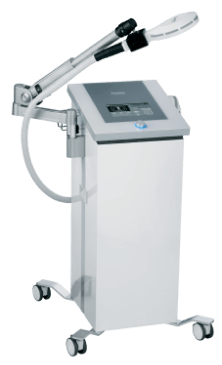
integrative rehabilitation group
Pelvic Floor Pain and Dysfunction

Verified by .Opencare.com
About Pelvic Floor Dysfunction
Pelvic pain is grossly mismanaged in conventional health care, often involving invasive and embarrassing manual interventions intended to relax hypertonic pelvic floor muscles, which is rarely the actual cause of pelvic pain. But pelvic pain itself is not the problem – most pelvic pain starts in other areas of the body, and treatment must address the original source.
Factors contributing to pelvic pain and dysfunction include:
- Autonomic nervous system hypersensitization
- Pelvic instability due to muscle weakness and SI joint dysfunction
- Fascia densifications and trigger points
- Issues with the feet that cause pelvic pain and misalignment
Our integrative approach to pelvic pain begins with a comprehensive exam using high-resolution diagnostic ultrasound. Ultrasound imaging gives us a clear picture of the body’s structures in motion, helping us to identify factors that contribute to pelvic pain. From there, we create a personalized treatment plan based on your unique diagnostic results.
Our Unique Approach to Pelvic Pain and Dysfunction
Conventional pelvic floor physical therapy typically relies on manual massage therapy aimed at relaxing tight pelvic floor muscles. However, hypertonic pelvic muscles are rarely the cause of pelvic dysfunction, and most pelvic therapists fail to provide long-term results.
At NYCIRG, our proprietary approach to pelvic pain treatment has a track record of success, helping patients to eliminate pelvic pain and restore optimal function.
Your pelvic therapy may include some or all of the following methods:

Shockwave therapy
Shockwave therapy uses high-frequency sound waves to stimulate tissue healing. Shockwaves are more effective than intrapelvic manual therapy because they can penetrate deep tissues that cannot be accessed via manual therapy. Shockwaves eliminate pain, calm hypersensitized nerves, and help to eliminate myofascial trigger points.
At NYCIRG, we use a variety of shockwaves to treat different tissue types. In particular, a combination of SoftWave electro-hydraulic waves with focused electromagnetic waves can be highly effective in alleviating pelvic pain.

Fascial manipulation therapy
Dr. Kalika is trained in the Stecco approach to fascial manipulation. Stecco is the only evidence-based method for eliminating fascial densifications, adhesions and trigger points, releasing entrapped nerves, and restoring fascia’s gliding properties. We sometimes use fascial manipulation in conjunction with interfascial plane and nerve hydrodissection.

Prolotherapy
Prolotherapy is a needling procedure that injects a neutral solution into slow-to-heal tissues. In the pelvic region, prolotherapy can help strengthen pelvic ligaments and pubic symphysis, to improve pelvic stability and relieve muscle spasms and other symptoms. Dr. Kalika teams up with an orthobiologic injection specialist, providing guidance via high-resolution ultrasound imaging.

Personalized physical therapy
Pelvic dysfunction is an umbrella term that covers a wide range of issues. We provide personalized one-on-one physical therapy, based on your unique diagnostic results.

Dr. Lev Kalika

Dr. Escudero
About Pelvic Pain Specialists Dr. Kalika and Dr. Escudero
Dr. Lev Kalika is a recognised expert in ultrasound guided procedures, with multiple peer-reviewed articles to his credit. Dr. Kalika has developed his own unique approach to pelvic floor treatment using ultrasound-guided dry needling, extracorporeal shock wave therapy (ESWT), neuromodulation, and other advanced treatment approaches. Dr. Kalika is an esteemed member of the International Pelvic Pain Society (IPPS) and the International Continence Society (ICS).
Dr. Daniela Escudero, DPT is a Certified Manual Physical Therapist who specializes in pelvic floor health, with an emphasis on functional movement and manual therapy. Dr. Escudero is dedicated to providing pelvic floor treatment that improves the quality of life of her patients.
The combined expertise of Dr. Kalika and Dr. Escudero makes NYCIRG the clinic of choice for pelvic floor physical therapy in NYC.

Pelvic Floor Conditions We Treat
- Urinary and/or fecal incontinence
- Constipation
- Pelvic organ prolapse
- Sexual dysfunction
- Pelvic pain
- Pelvic muscle spasms
- Postpartum issues
- Surgery recovery
- Nerve compression
- Vulvodynia
- Prostatitis
- Painful bladder
- Pudendal neuralgia
- Vaginismus
- Central desensitization
- Erectile dysfunction and pain
- Pain during intercourse
- SI joint pain
- Pain after hysterectomy
- Testicular pain
- Coccydynia pain
Accurate Diagnosis is Key to Successful Pelvic Floor Treatment
At NYCIRG, diagnosis begins with a medical history and physical exam of the pelvic floor, low back, hips and pelvis. Your clinician will ask for detailed information about pregnancies, and any difficulties associated with childbearing.
High resolution dynamic ultrasound lets us visualize the pelvic region with the patient in motion, to rule out hip and low back issues, and to assess for muscular deficits, excessive force production (pressure) and trigger points.
With real-time ultrasound imaging, we are able to diagnose and treat a number of issues related to pelvic dysfunction, including:
- Low back pain
- Chronic pelvic pain
- Hip and groin pain
- Postpartum issues
- Urinary and bowel incontinence
- Post-surgical issues
- Factors related to the autonomic nervous system
- Factors related to the feet and lower kinetic chain


Get Pelvic Floor Treatment that Really Works
Conventional physical therapy often approaches pelvic pain with invasive and embarrassing manual hypertonic pelvic floor treatment that rarely provides lasting results. At NYCIRG, we strongly believe that tight pelvic floor muscles are rarely the underlying cause of pelvic pain, and that hypertonic muscles are always secondary to other factors.
In our experience, pelvic pain is multifactorial and more often originates from:
- Hypersensitized pelvic nerves
- Walking gait deficits originating in the feet and lower kinetic chain
- Imbalances between intra pelvic and intra abdominal pressure.
- Fascia densifications in the abdominal wall and surrounding the pelvic organs
- Pelvic instability stemming from muscle weakness and SI joint dysfunction
Before beginning physical therapy, we use our advanced technologies to:
- Modulate pelvic nerves
- Eliminate pelvic densifications and adhesions
- Regenerate and strengthen pelvic tendon and ligament tissues
- Eliminate intra-pelvic trigger points and relax pelvic muscle tone.
Pre-treatment of these issues paves the way for physical therapy to restore optimal function in the lumbopelvic-hip region. Our unique approach enables us to successfully treat a broad range of pelvic conditions
Advanced Technologies are Game-Changers
for Pelvic Floor Physical Therapy
Cutting-edge technologies, advanced therapeutic approaches and orthobiologic needling procedures help to jump-start the healing process and expedite recovery.
Our advanced technologies include:

SoftWave Electro-Hydraulic Shockwave Therapy
SoftWave Electro-Hydraulic Shockwave Therapy
SoftWave is a groundbreaking mechanotransduction technology that accelerates tissue healing with defocused and linear focused shockwaves. SoftWave’s wider and deeper penetration makes it a preferred treatment option for pelvic dysfunction.
Myofascial Acoustic Compression Therapy (MyACT)
MyACT’s focused shockwave technology transforms the mechanical energy of shockwaves into biochemical signals that precisely target damaged tissues. Its higher frequency allows for precise neuro modulation under ultrasound guidance, with a special linear head for treating myofascial pain.

Myofascial Acoustic Compression Therapy (MyACT)

Focused Shockwave Therapy (ESWT)
Extracorporeal Shockwave Therapy (ESWT)
Focused ESWT produces high frequency sound waves to stimulate the body’s own reparative mechanisms. It is especially effective for pelvic pain when combined with other technologies like SoftWave and EMTT.
Extracorporeal Magnetic Transduction Therapy (EMTT)
EMTT transmits high energy magnetic pulses that synchronize with the body’s own magnetic fields, triggering a healing response. EMTT waves are able to penetrate tissues deep within the pelvic bowl.

Electromagnetic Transduction Therapy (EMTT)

High Energy Inductive Therapy (HEIT)
High Energy Inductive Therapy (HEIT)
HEIT delivers high-intensity magnetic pulses to peripheral tissues, to stimulate neuroplasticity. We leverage this FDA-approved methodology to treat pain and regenerate nerve fibers, for enhanced motor control.
INDIBA Radiofrequency Therapy
INDIBA is a form of TECAR therapy that helps to restore the ionic charge of damaged tissues for faster injury healing and rehabilitation.

INDIBA Radiofrequency Therapy

NESA Neuromodulation Therapy
The NESA device delivers a biphasic low-frequency electrical current to calm hypersensitized nerves and restore optimal neural signaling to the brain.
We Guide Our Needling and Orthobiologic
Procedures with High-Resolution Ultrasound
Injection therapies use orthobiologic solutions that stimulate tissue repair by either nourishing or irritating the targeted area. Dr. Kalika teams up with an orthobiologic injection specialist, guiding needling procedures with high-resolution ultrasound.

Platelet Rich Plasma (PRP)
PRP therapy uses a high concentration of platelets extracted from the patient’s own blood. When injected into damaged tissues, PRP initiates tissue repair by releasing biologically active factors such as growth factors, cytokines, lysosomes and adhesion proteins. The injected solution stimulates the synthesis of new connective tissues and blood vessels.
Alpha-2-Macroglobulin (A2M)
Alpha 2 macroglobulin (A2M) is a naturally occurring blood plasma protein that acts as a carrier for numerous proteins and growth factors. As a protease inhibitor, A2M reduces inflammation in arthritic joints and helps to deactivate a variety of proteinases that typically degrade cartilage.
Prolotherapy
Prolotherapy uses a biologically neutral solution to irritate stubborn tissues, triggering the body’s innate healing mechanisms to grow new normal tendon, ligament and muscle fibers.
Interfascial Plane and Nerve Hydrodissection
Pelvic dysfunction often involves fascial tissue that has become densified and/or formed adhesions, entrapping nerves and blood vessels, and causing pain. The hydrodissection procedure injects a saline solution into densified fascia under ultrasound guidance. The solution works by separating fascial layers and freeing up entrapped nerves and blood vessels. We often use hydrodissection in conjunction with manual fascial manipulation.

Percutaneous Neuromodulation for Pelvic Pain
The tissues and organs of your pelvic region are innervated by a group of nerves that form the sacral plexus, part of the greater lumbosacral plexus that originates in the lower spine. The sacral plexus consists of motor and sensory nerves that affect the posterior thigh, the lower leg, the entire foot, and parts of the pelvis. Pelvic pain often arises from irritation of one or more nerves within the sacral plexus.
The pudendal nerve is part of the sacral plexus and innervates most of the pelvis. Its sensory function innervates both male and female external genitalia and the skin around the anus, anal canal and perineum. Its motor function innervates various pelvic muscles, the external urethral sphincter, and the external anal sphincter.
Percutaneous neuromodulation (PENS) is a therapeutic approach that uses electrical stimuli to calm and desensitize hyperactivated nerves. It involves the insertion of several filament-thin needles under ultrasound guidance into muscle tissue adjacent to the targeted nerve. PENS stimulates the nerve with varying waves of low frequency electrical current to help restore optimal neural function.
PENS is used in conjunction with other therapies to treat pelvic pain and dysfunction by:
- Regulating nerve function
- Improving brain plasticity and muscle recruitment patterns
- Reducing pain
- Restoring muscle function
- Eliminating myofascial trigger points
PENS is often used in combination with other first-line treatments such as extracorporeal shockwave therapy (ESWT) , electromagnetic transduction therapy (EMTT), TECAR therapy, chiropractic care and physical therapy. PENS can also be used as a stand-alone treatment for pelvic pain. Successful PENS therapy requires only about 4-6 sessions.

Pelvic Fascial Manipulation – the Missing Link in Pelvic Pain Treatment
The superficial fascia of the pelvic floor is a thin fibrous layer of connective tissue embedded with adipocytes – specialized fat cells – along with a complex network of lymphatic and blood vessels. The pelvic fascia plays an important role in exteroception – sensory awareness of stimuli outside the body.
Fascia tissue has a high percentage of elastic fibers and a slippery coating of hyaluronan that facilitates the gliding of nerves and blood vessels. The pelvic fascia works together with the transversus abdominis, diaphragm and pelvic floor muscles to optimize abdominal pressure, providing spinal stability. Its autonomic innervation makes the pelvic fascia sensitive to stress and changes in temperature, and it is intricately connected to the genitalia.
Pelvic fascia manipulation is often the missing link in pelvic pain treatment. Pelvic pain is mostly generated from hyperactive nerves embedded in the deep fascia of the pelvis. These include peripheral nerves like the pudendal, gluteal and cluneal nerves that glide between the pelvic floor muscles and can be released from entrapment by manipulation of the endomysium and perimysium.

Other sensory nerves and their endings inhabit the superficial fascia, such as the ilioinguinal, iliohypogastric and genitofemoral nerves. When your parasympathetic nerves are entrapped in the superficial fascia they become hyperactivated, generating pelvic pain.
The intimate connection between the deep and superficial fascia layers has been largely overlooked in conventional treatment of pelvic pain. Most doctors and therapists focus on injections to block the pudendal nerve, and on manual release of trigger points.
According to evidence-based research, pelvic fascia manipulation therapy not only releases densified layers of superficial and deep fascia, but also calms hypersensitized nerves. Other therapies, such as ultrasound-guided electro acupuncture, are often used in conjunction with fascial manipulation for the neuromodulation of hyperactive pelvic nerves.
Get the Most Effective Pelvic Floor Treatment in NYC
Patients suffering from pelvic floor pain and dysfunction want physical therapy that eliminates their symptoms for good. Yet typical pelvic therapy consists of embarrassing hypertonic pelvic floor treatment that involves manual intra vaginal or intra rectal release techniques that don’t get to the root cause of your condition, providing only temporary relief, with no significant progress.
At NYCIRG, we combine advanced technologies and therapies with personalized state-of-the-art physical therapy. Our holistic treatment approach goes beyond pain management to actually correct the causes of pelvic pain and dysfunction. Our track record of successful and lasting pelvic floor treatment makes NYCIRG the top-rated physical therapy clinic for pelvic pain in NYC.

Hours of Operation


